heater CHEVROLET CAMARO 1994 4.G Owners Manual
[x] Cancel search | Manufacturer: CHEVROLET, Model Year: 1994, Model line: CAMARO, Model: CHEVROLET CAMARO 1994 4.GPages: 292, PDF Size: 15.35 MB
Page 11 of 292
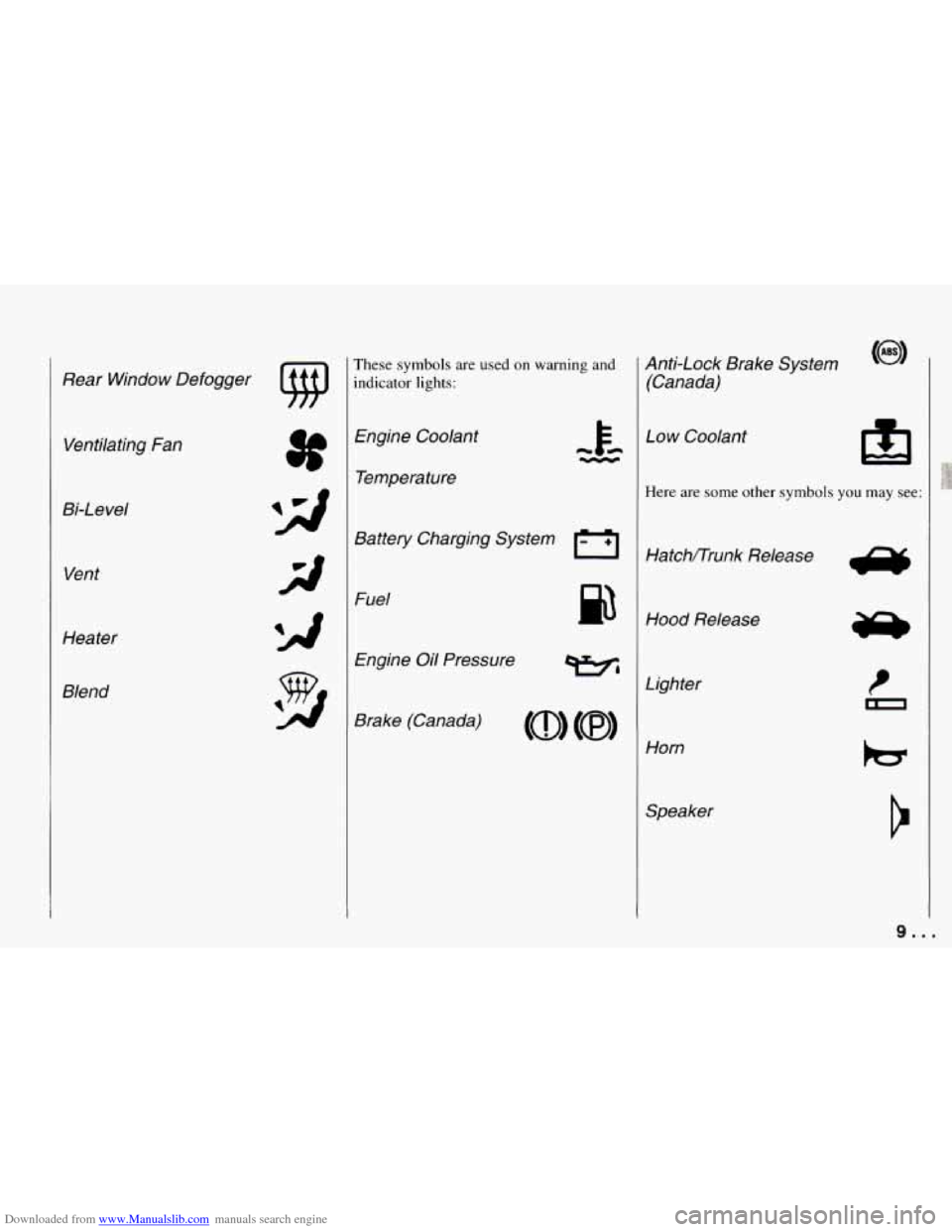
Downloaded from www.Manualslib.com manuals search engine Rear Window Defogger Ventilating Fan
Bi-Level Vent
Heater
Blend
These symbols are used on warning and
indicator lights:
Engine Coolant
Temperature
Battery Charging System
El
Fuel
Engine Oil Pressure
Brake (Canada) Anti-Lock Brake System
(Canada)
Low Coolant
m
Here are some other symbols you may see:
Hatchflrunk Release
Hood Release
Lighter Horn
B
k3
Speaker
9..
Page 61 of 292
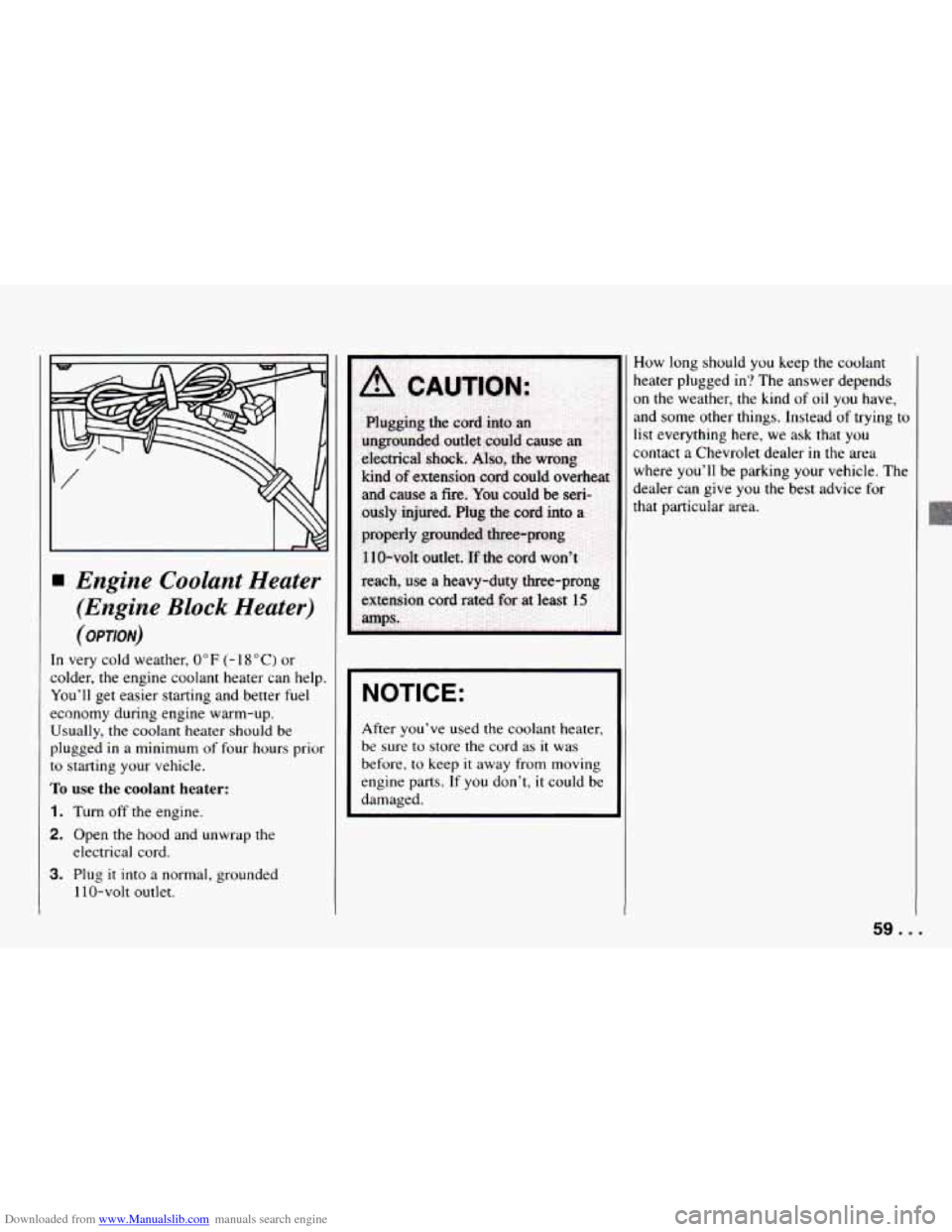
Downloaded from www.Manualslib.com manuals search engine Engine Coolant Heater
(Engine Block Heater)
(OPTION)
In very cold weather, 0°F (- 1 8 "Cj or
colder, the engine coolant heater can help.
You'll get easier starting and better fuel
economy during engine warm-up.
Usually, the coolant heater should be
plugged
in a minimum of four hours prior
to starting your vehicle.
To use the coolant heater:
1. Turn off the engine.
2. Open the hood and unwrap the
electrical cord.
3. Plug it into a normal, grounded
110-volt outlet.
NOTICE:
After you've used the coolant heater,
be sure
to store the cord as it was
before, to keep
it away from moving
engine parts.
If you don't, it could be
damaged.
How long should you keep the coolant
heater plugged in? The answer depends
on the weather, the kind
of oil you have,
and some other things. Instead
of trying to
list everything here, we ask that
you
contact a Chevrolet dealer in the area
where you'll be parking your vehicle. The
dealer can give
you the best advice for
that particular area.
59. .
Page 109 of 292
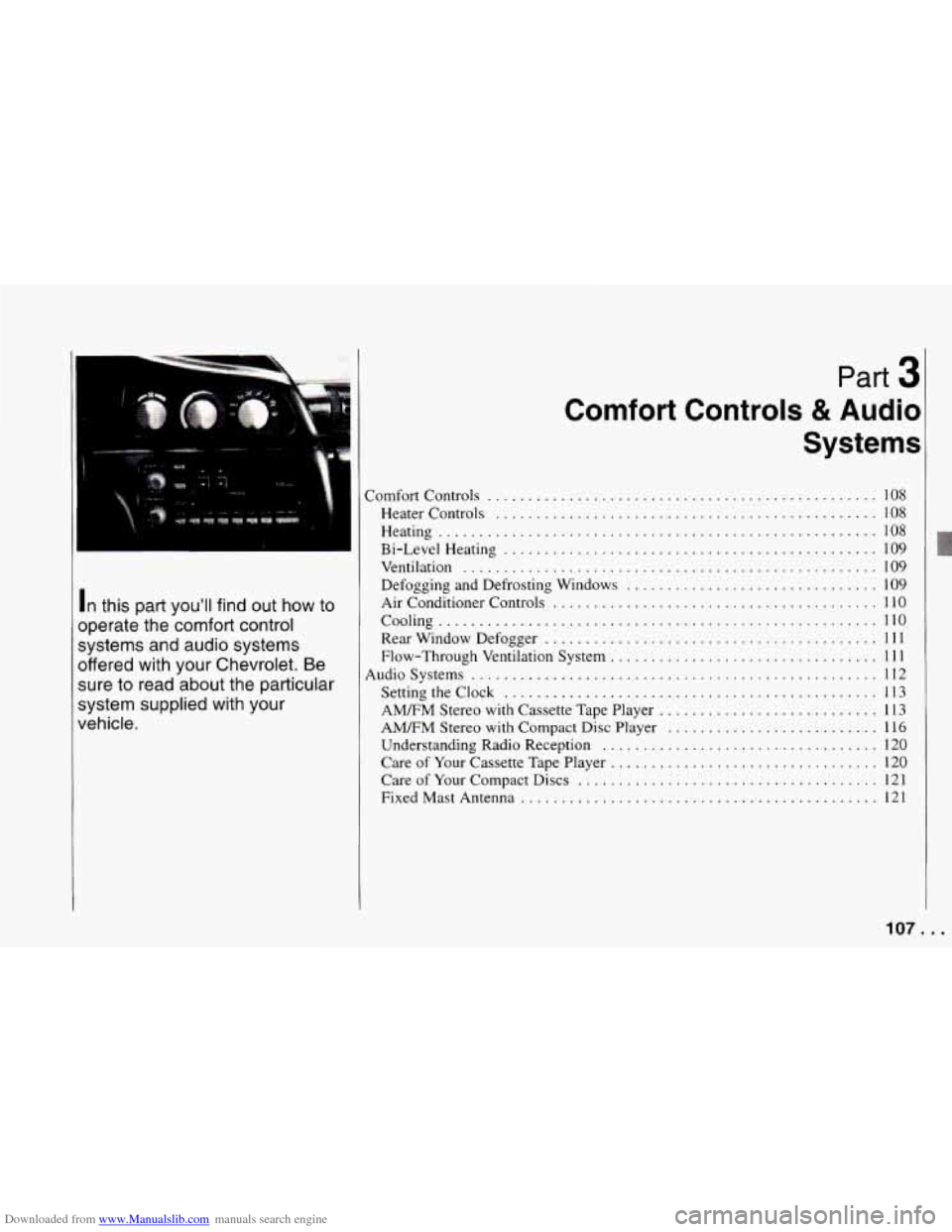
Downloaded from www.Manualslib.com manuals search engine In this part you’ll find out how to
)perate the comfort control
systems and audio systems
lffered with your Chevrolet
. Be
sure to read about the particular
system supplied with your
rehicle
.
Part 3
Comfort Controls & Audio
Systems
Comfort Controls ................................................ 108
Heatercontrols
............................................... 108
Heating ...................................................... 108
Bi-LevelHeating .............................................. 109
Ventilation
................................................... 109
Defogging and Defrosting Windows
............................... 109
Air Conditioner Controls
........................................ 110
Cooling ...................................................... 110
Rearwindow Defogger
......................................... 111
Audiosystems .................................................. 112
Flow-Through Ventilation System ................................. 111
Settingtheclock .............................................. 113
AMEM Stereo
with Cassette Tape Player ........................... 113
AM/FM Stereo with Compact Disc Player .......................... 116
Understanding Radio Reception .................................. 120
Care of Your Cassette Tape Player
................................. 120
Care of Your Compact Discs ..................................... 121
FixedMastAntenna
............................................ 121
107 ...
Page 110 of 292
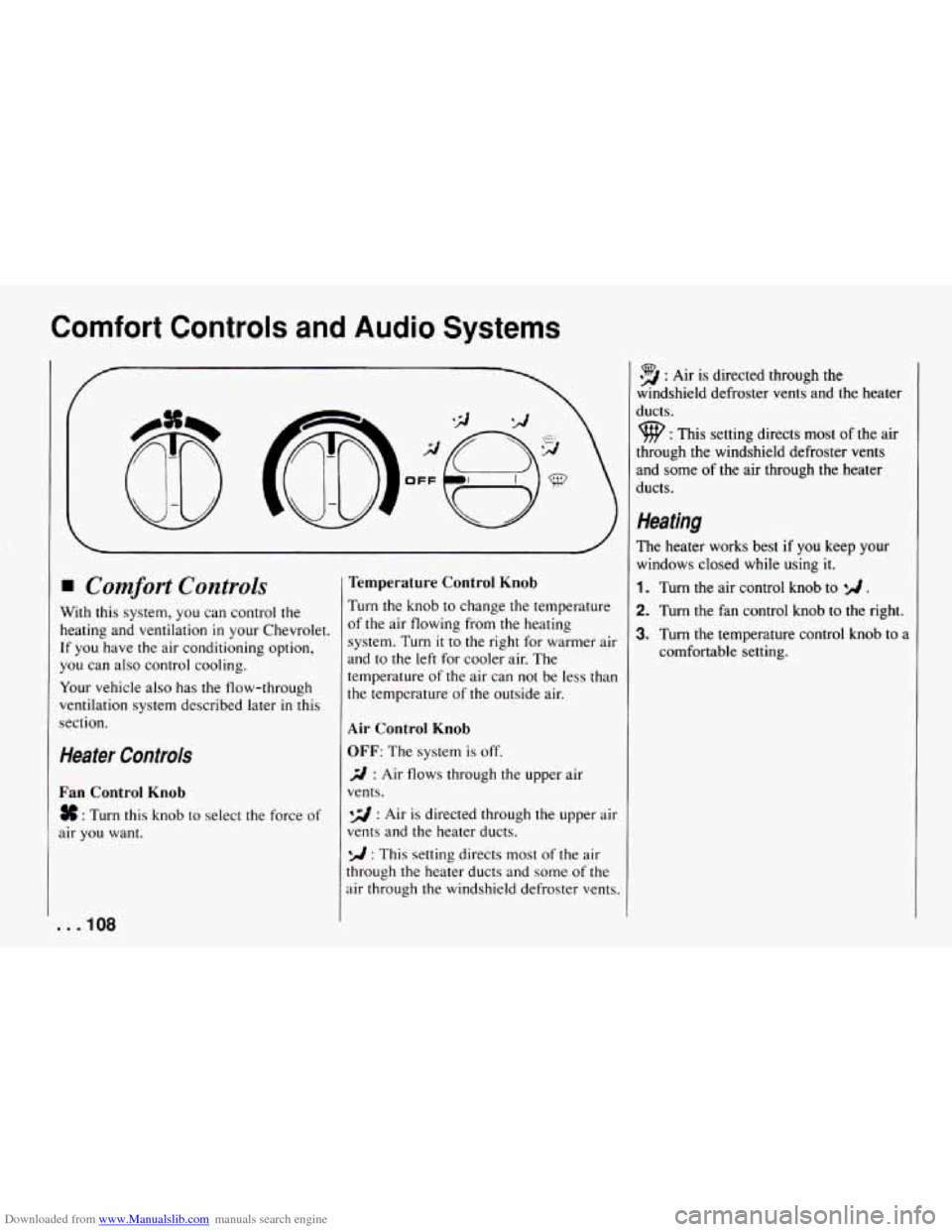
Downloaded from www.Manualslib.com manuals search engine Comfort Controls and Audio Systems
E/
OFF
Comfort Controls
With this system, you can control the
heating and ventilation
in your Chevrolet.
If you have the air conditioning option,
you can also control cooling.
Your vehicle also has the flow-through
ventilation system described later
in this
section.
Heater Controls
Fan Control Knob
# : Turn this knob to select the force of
air you want.
. . ,108
Temperature Control Knob
Turn the knob to change the temperature
of the air flowing from the heating
system. Turn
it to the right for warmer air
and to the left for cooler air. The
temperature
of the air can not be less than
the temperature
of the outside air.
Air Control Knob
OFF: The system is off.
3 : Air flows through the upper air
vents.
*d : Air is directed through the upper air
vents and the heater ducts.
*A : This setting directs most of the air
through the heater ducts and some of the
air through the windshield defroster vents.
39 : Air is directed through the
windshield defroster vents and the heater
ducts.
9 : This setting directs most of the air
through the windshield defroster vents
and some
of the air through the heater
ducts.
Heating
The heater works best if you keep your
windows closed while using it.
1. Turn the air control knob to */I .
2. Turn the fan control knob to the right.
3. Turn the temperature control knob to a
comfortable setting.
Page 111 of 292
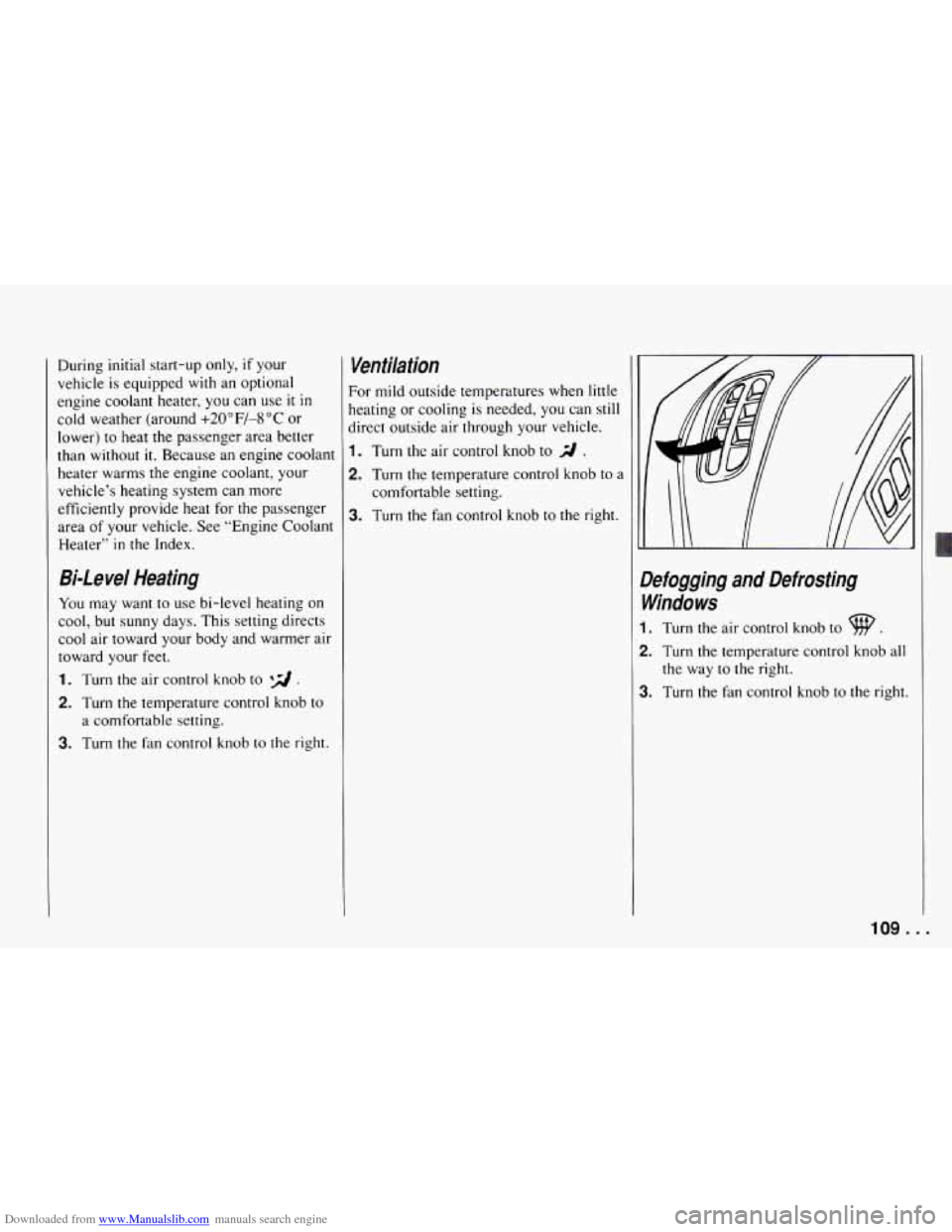
Downloaded from www.Manualslib.com manuals search engine During initial start-up only, if your
vehicle is equipped with an optional
engine coolant heater, you can
use it in
cold weather (around +2OoF/-8”C or
lower) to heat the passenger area better
than without
it. Because an engine coolant
heater warms the engine coolant, your
vehicle’s heating system can more
efficiently provide heat for the passenger
area of your vehicle. See “Engine Coolant
Heater’’
in the Index.
Bi-Level Heating
You may want to use bi-level heating on
cool, but sunny days. This setting directs
cool air toward
your body and warmer air
toward your feet.
1. Turn the air control knob to *g .
2. Turn the temperature control knob to
3. Turn the fan control knob to the right.
a comfortable setting.
Ventilation
For mild outside temperatures when little
neating or cooling is needed, you can still
iirect outside air through your vehicle.
1. Turn the air control knob to 9 .
2. Turn the temperature control knob to a
3. Turn the fan control knob to the right.
comfortable setting.
7efogging and Defrosting
Nindo
ws
. Turn the air control knob to 9.
!. Turn the temperature control knob all
1. Turn the fan control knob to the right.
the
way to
the right.
109. I
Page 112 of 292
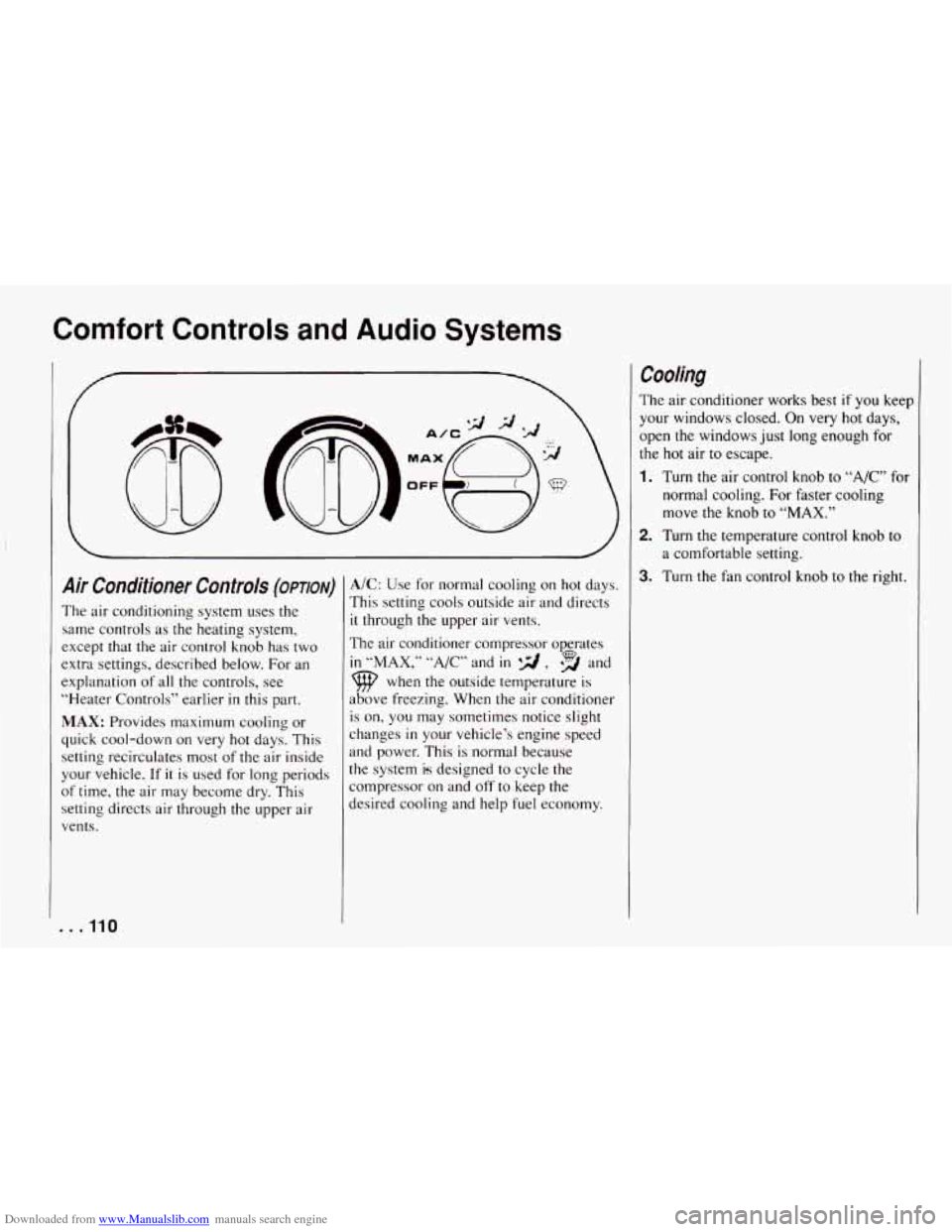
Downloaded from www.Manualslib.com manuals search engine Comfort Controls and Audio Systems
Air Conditioner Controls (OPTION)
The air conditioning system uses the
same controls as the heating system,
except that the air control knob has two
extra settings, described below. For an
explanation of all
the controls, see
“Heater Controls” earlier
in this part.
MAX: Provides maximum cooling or
quick cool-down
on very hot days. This
setting recirculates most
of the air inside
your vehicle. If
it is used for long periods
of time, the air may become dry. This
setting directs
air through the upper air
vents.
. . ,110
A/C: Use for normal cooling on hot days.
This setting cools outside air and directs
it through the upper air vents,
The air conditioner compressor operates
in “MAX,” “A/C” and in qd , *% and
9 when the outside temperature is
above freezing. When the air conditioner
is on, you
may sometimes notice slight
changes
in your vehicle’s engine speed
and power. This is normal because
the system
is designed to cycle the
compressor on and off to keep the
desired cooling
and help fuel economy.
Cooling
The air conditioner works best if you keep
your windows closed. On very hot
days,
open the windows just long enough for
the hot air to escape.
1. Turn the air control knob to “A/C” for
normal cooling. For faster cooling
move the knob to
“MAX.”
2. Turn the temperature control knob to
a comfortable setting.
3. Turn the fan control knob to the right.
Page 114 of 292
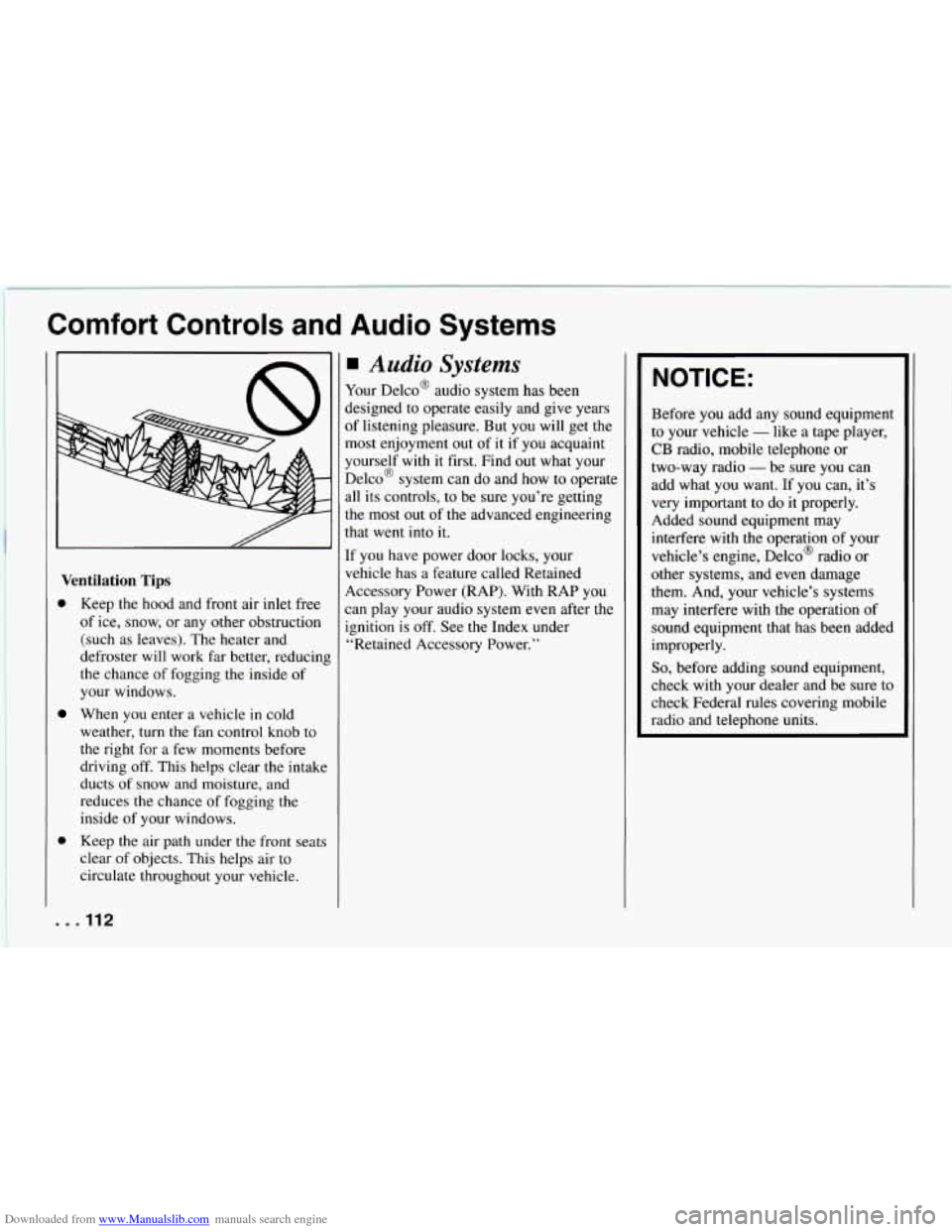
Downloaded from www.Manualslib.com manuals search engine Comfort Controls and Audio Systems
Ventilation Tips
D Keep the hood and front air inlet free
of ice, snow, or any other obstruction
(such as leaves). The heater and
defroster will work far better, reducin
the chance of fogging the inside of
your windows.
When
you enter a vehicle in cold
weather, turn the fan control knob to
the right for a few moments before
driving off. This helps clear the intakc
ducts of snow and moisture, and
reduces the chance of fogging the
inside of your windows.
Keep the air path under the front seat:
clear of objects. This helps air to
circulate throughout your vehicle.
.I12
I‘
Audio Systems
Your Delco@ audio system has been
jesigned to operate easily and give years
If listening pleasure. But you will get the
nost enjoyment out of
it if you acquaint
yourself
with it first. Find out what your
Delco@ system can do and how to operate
111 its controls, to be sure you’re getting
:he most out
of the advanced engineering
.hat went into
it.
:f you have power door locks, your
qehicle has a feature called Retained
4ccessory Power (RAP). With RAP you
:an
play your audio system even after the
ignition
is off. See the Index under
“Retained Accessory Power.”
NOTICE:
Before you add any sound equipment
to your vehicle
- like a tape player,
CB radio, mobile telephone or
two-way radio
- be sure you can
add what you want. If you can, it’s
very important
to do it properly.
Added sound equipment may
interfere with the operation of your
vehicle’s engine, Delco@ radio or
other systems, and even damage
them. And, your vehicle’s systems
may interfere with the operation
of
sound equipment that has been added
improperly.
So, before adding sound equipment,
check with your dealer and be sure to
check Federal rules covering mobile
radio and telephone units.
Page 144 of 292
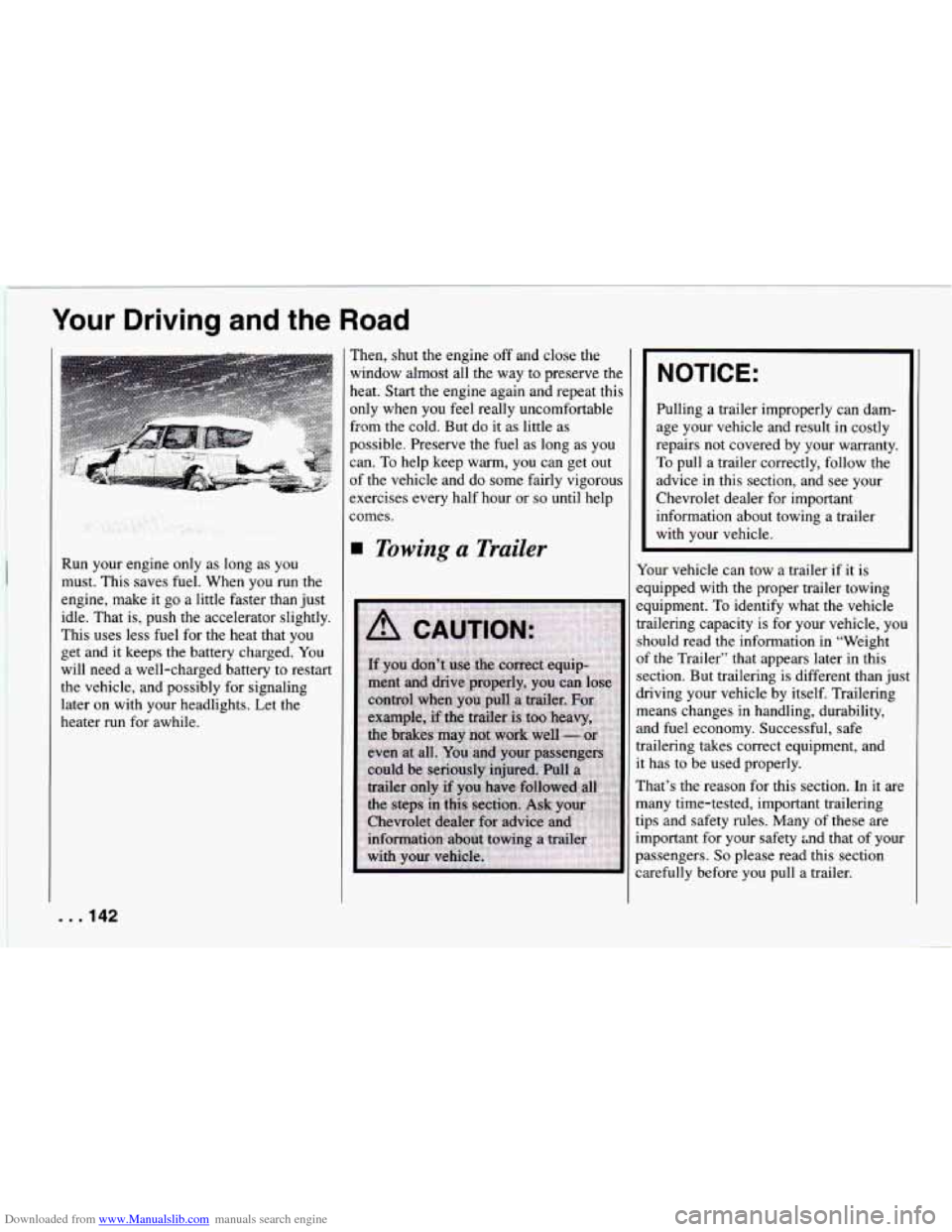
Downloaded from www.Manualslib.com manuals search engine Your Driving and the Road
Run your engine only as long as you
must. This saves fuel. When you run the
engine, make it go a little faster than just
idle. That is, push the accelerator slightly.
This uses less fuel for the heat that you
get and it keeps the battery charged.
You
will need a well-charged battery to restart
the vehicle, and possibly for signaling
later on with your headlights. Let the
heater run for awhile. Then,
shut the engine
off and close the
window almost all the way to preserve the
heat. Start the engine again and repeat this
only when you feel really uncomfortable
from the cold. But do it as little as
possible. Preserve the fuel as long as you
can. To help keep warm, you can get out
of the vehicle and do some fairly vigorous
exercises every half hour or
so until help
comes.
Towing a Trailer
NOTICE:
Pulling a trailer improperly can dam-
age your vehicle and result in costly
repairs not covered
by your warranty.
To pull a trailer correctly, follow the
advice
in this section, and see your
Chevrolet dealer for important
information about towing a trailer
with your vehicle.
Your vehicle can tow a trailer if it is
equipped with the proper trailer towing
equipment. To identify what the vehicle
trailering capacity is for your vehicle, you
should read the information in “Weight
of the Trailer” that appears later in this
section. But trailering is different than just
driving your vehicle by itself. Trailering
means changes in handling, durability,
and fuel economy. Successful, safe
trailering takes correct equipment, and
it has to be used properly.
That’s the reason for this section. In it are
many time-tested, important trailering
tips and safety rules. Many of these are
important for your safety md that of your
passengers.
So please read this section
carefully before you pull a trailer.
. . .142
Page 160 of 292
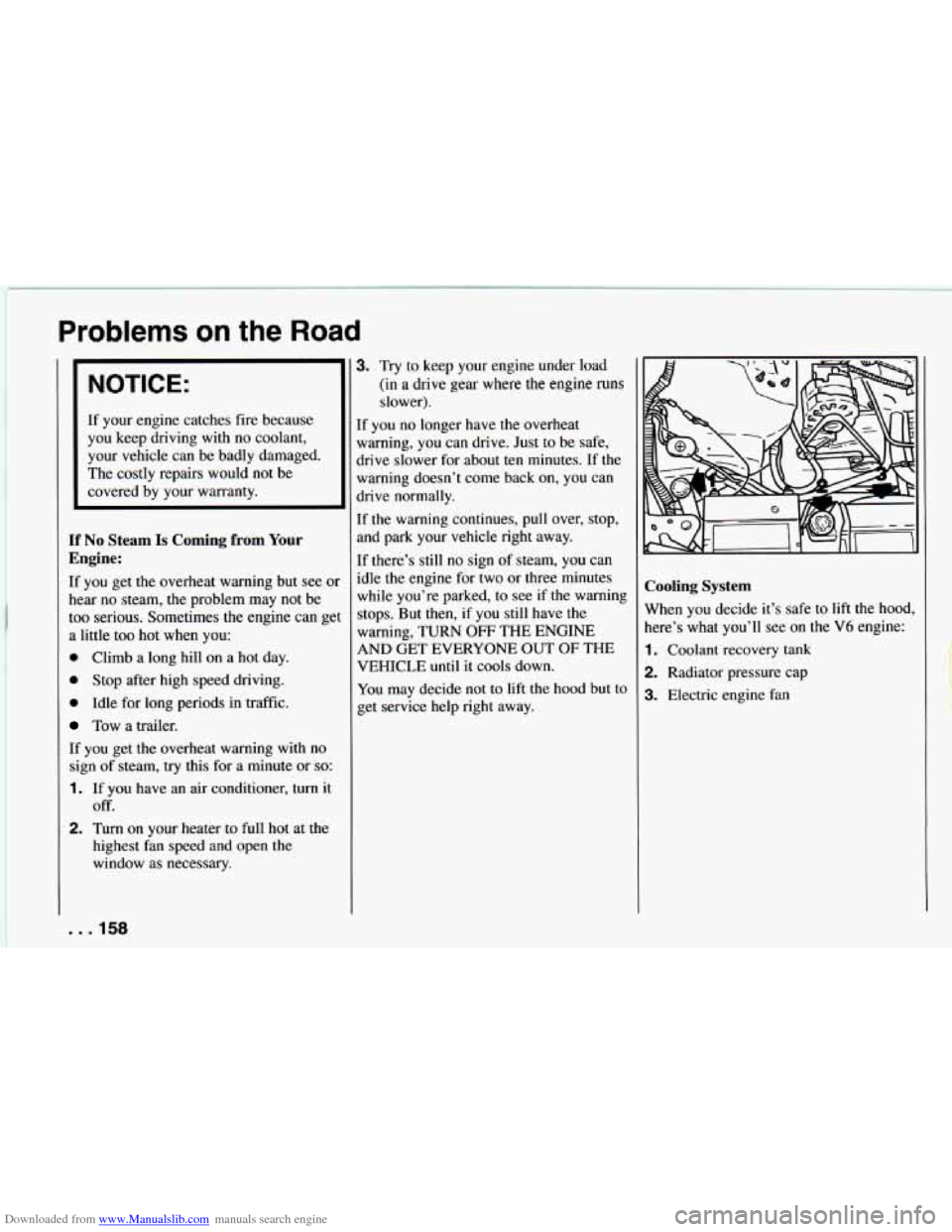
Downloaded from www.Manualslib.com manuals search engine Problems on the Road
NOTICE:
If your engine catches fire because
you keep driving with
no coolant,
your vehicle can be badly damaged.
The costly repairs would not be
covered by your warranty.
If No Steam Is Coming from Your
Engine:
If you get the overheat warning but see or
hear no steam, the problem may not be
too serious. Sometimes
the engine can gel
a little too hot when you:
0 Climb a long hill on a hot day.
0 Stop after high speed driving.
0 Idle for long periods in traffic.
Tow a trailer.
If you get
the overheat warning with no
sign of steam,
try this for a minute or so:
1. If you have an air conditioner, turn it
2. Turn on your heater to full hot at the
off.
highest fan speed and open
the
window as necessary.
3. Tr!
to keep your engine under load
(in a drive gear where the engine runs
slower).
[f you no longer have the overheat
warning, you can drive. Just to be safe,
drive slower for about ten minutes. If the
warning doesn’t come back on,
you can
drive normally.
[f the warning continues, pull over, stop,
and park your vehicle right away.
If there’s still no sign of steam, you can
idle the engine for two or three minutes
while you’re parked, to see if the warning
stops. But
then, if you still have the
warning, TURN
OFF THE ENGINE
AND GET EVERYONE
OUT OF THE
VEHICLE until it cools down.
You may decide not to lift the hood but to
get service help right away.
Cooling System
When you decide it’s safe to lift the hood,
here’s what you’ll see on the
V6 engine:
1. Coolant recovery tank
2. Radiator pressure cap
3. Electric engine fan
. . .158
Page 161 of 292
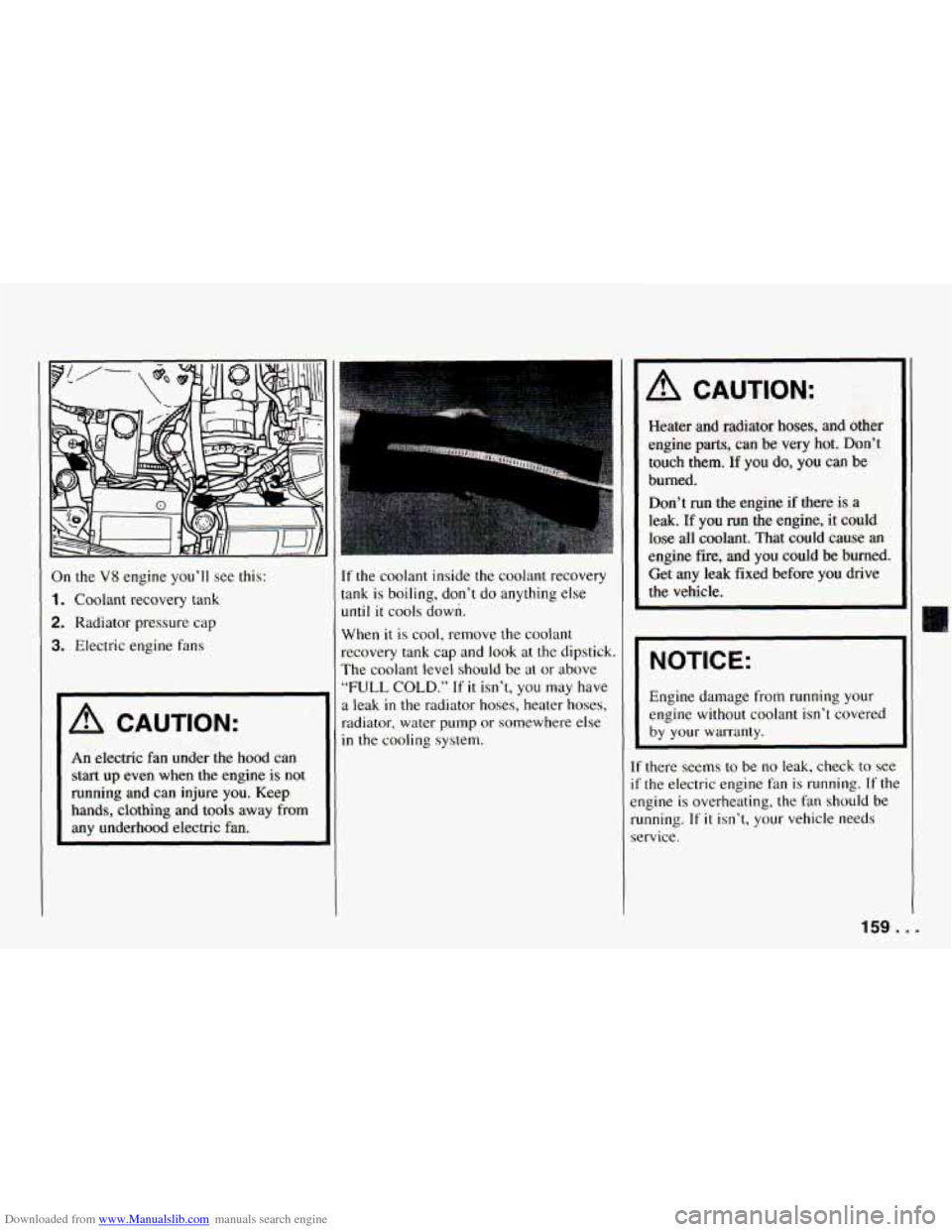
Downloaded from www.Manualslib.com manuals search engine On the V8 engine you’ll see this:
1. Coolant recovery tank
2. Radiator pressure cap
3. Electric engine fans
A CAUTION:
An electric fan under the hood can
start up even when the engine is not
running and can injure
you. Keep
hands, clothing and tools
away from
any underhood electric fan.
II
If the coolant inside the coolant recovery
tank is boiling, don’t do anything else
until it cools down.
When
it is cool, remove the coolant
recovery tank cap and look at
the dipstick.
The coolant level should be at or above
“FULL COLD.” If it isn’t, you may have
a leak
in the radiator hoses, heater hoses,
radiator,
water pump or somewhere else
in the cooling system.
A CAUTION:
Heater and radiator hoses, and other
engine parts, can be very hot. Don’t
touch them. If you do, you can be
burned.
Don’t
run the engine if there is a
leak. If you run the engine, it could
lose all coolant. That could
cause an
engine fire, and you could be burned.
Get any leak fixed before you drive
the vehicle.
NOTICE:
Engine damage from running your
engine without coolant isn’t covered
by your warranty. I
If there seems to be no leak, check to see
if the electric engine fan is running. If the
engine
is overheating, the fan should be
running.
If it isn’t, your vehicle needs
service.
159. I